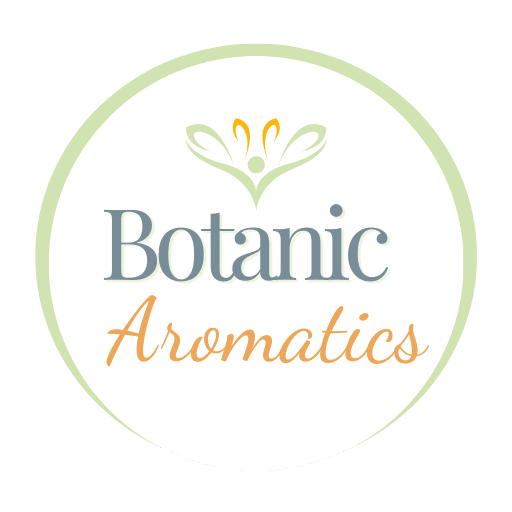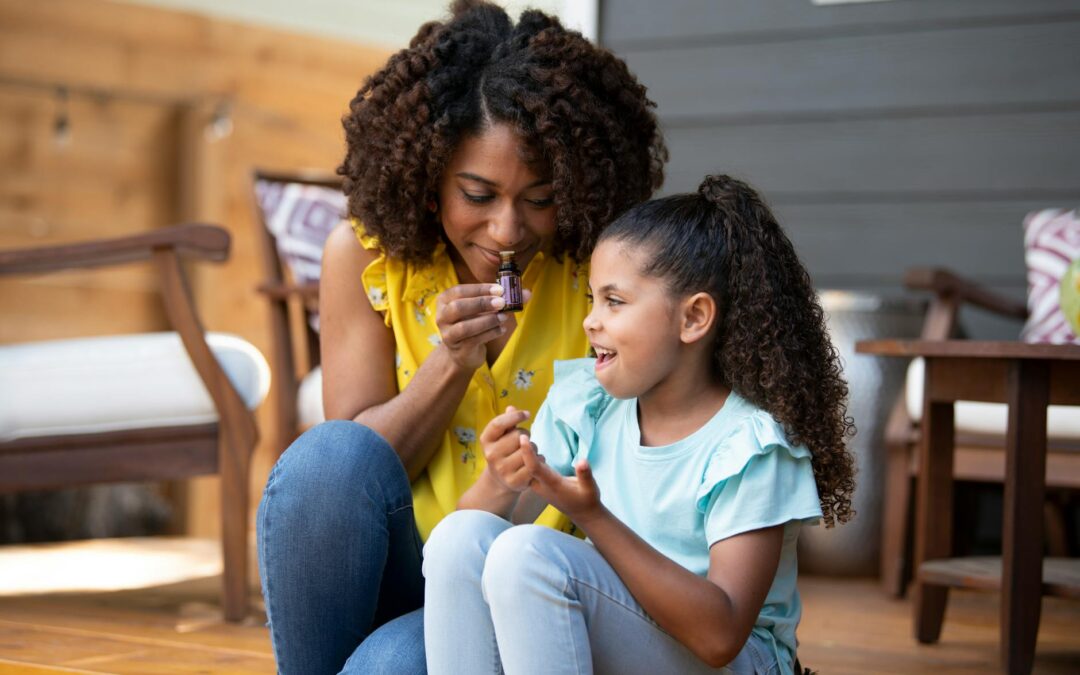Navigating the aromatic world of essential oils with children requires a delicate touch, a dash of caution, and a deep well of knowledge. As guardians of their well-being, it’s our responsibility to blend the ancient wisdom of natural remedies with the precision of modern science.
This journey into essential oils is not just about discovering natural solutions for the sniffles or a pathway to sweeter dreams; it’s about fostering an environment where the potent power of nature’s extracts harmonizes with the sensitive nature of childhood. With a foundation grounded in organic chemistry and a heart attuned to the gentle whispers of aromatherapy, we embark on a guided exploration.
This guide will give basic information on the safe use of essential oils so you can safely integrate the healing essence of plants into your child’s life safely and effectively. Whether you’re seeking solace for skin scrapes or serenity at bedtime, the key lies in understanding the delicate balance between nature’s potency and a child’s vulnerability. Let’s begin this journey with open minds and tender care, ensuring every drop of essential oil opens a chapter of wellness in your child’s life. As a further safety consideration, always consult a qualified healthcare practitioner before using essential oils with infants and children.
The delicate systems of young ones require that we approach essential oils with prudence and respect for their developing bodies. Here’s a detailed guide on the ages when essential oils may be used and the recommended delivery routes:
Use by Age:
Newborns to 3 Months
Use: Essential oils in any form should generally be avoided due to newborns’ susceptible skin and developing respiratory systems. Only expose children in this age group if you are working under the express direction of a healthcare professional.
3 Months to 2 Years
Use: Essential oils can begin to be introduced very cautiously for specific concerns, such as promoting relaxation or aiding in minor skin irritations.
Delivery Method:
Topical: Only mild essential oils, such as Lavender (Lavandula angustifolia) and Roman Chamomile (Chamaemelum nobile), should be considered, and they must be diluted significantly. A safe dilution for this age group is one drop of essential oil in 2 tablespoons (30mls) of carrier oil.
*Diffusion: If diffusing, ensure it’s in a well-ventilated area for a limited time (15-30 minutes) and observe the child for any adverse reactions. The diffuser should be placed out of reach, and the child should not be left unattended in the room with the diffuser operating.
2 Years to 6 Years
Use: A broader range of essential oils can be introduced to calm before bedtime, soothe minor skin irritations, or ease respiratory congestion.
Delivery Method:
Topical: Dilution remains essential, with a recommended ratio of one drop of essential oil to one tablespoon of carrier oil. Application should be limited to areas like the feet, back, or chest, avoiding sensitive areas.
Diffusion: Safe for short periods (30-60 minutes), ensuring the child is comfortable with the scent and shows no signs of distress or irritation.
6 Years to 10 Years
Use: Essential oil use can be expanded further, including for focus and concentration, supporting immune function, and more significant skin issues.
Delivery Method:
Topical: The dilution can be slightly less, with a general guideline of 1-2 drops of essential oil per tablespoon of carrier oil. Test on a small skin area first.
Diffusion: It is suitable for longer periods, up to an hour or two, depending on the oil’s potency and the child’s reaction. Always ensure good ventilation and keep out of reach for younger children.
10 Years and Older
Use: Children in this age group can handle a dilution ratio similar to adults for most essential oils, though starting on the cautious side is wise. They can benefit from essential oils for academic stress, sports recovery, and hormonal changes.
Delivery Method:
Topical: Depending on the child’s sensitivity, the dilution can be adjusted to 1 drop of essential oil per teaspoon of carrier oil for regular use. Patch the test, start with the minimum amount, and work up.
Diffusion: This can be used more liberally, mirroring adult usage, but with continued attention to the child’s feedback and any potential reactions.
General Recommendations
Ingestion: Essential oil ingestion is not recommended unless you are under the care of a qualified healthcare practitioner trained for the internal use of essential oils. This is especially a concern for children due to the risk of toxicity and the complexity of determining safe dosages. Internal use of essential oils can lead to life-threatening events in spite of what clever marketers would have you believe
Consultation: Before introducing essential oils, particularly for therapeutic purposes, consulting a healthcare provider or a certified aromatherapist, especially for children with health conditions, allergies, or sensitivities, is crucial.
Understanding these guidelines ensures that essential oils can be a safe, nurturing addition to a child’s care regimen, offering natural support for their physical and emotional well-being as they grow.
Administration Methods
Topical Application: Apply the blend to the child’s skin after diluting it with a carrier oil. Common areas include the chest, back, feet, and areas affected by specific ailments. Please see the Use by Age section for recommended dilution rates.
Diffusion: Use an essential oil diffuser to disperse the oil into the air. Ensure the room is well-ventilated, and limit diffusion to 30-60 minutes.
*Please note: The number of drops recommended for a diffuser can vary based on the diffuser’s size, room size, and personal scent preference. However, a general guideline for most standard diffusers (typically with a water tank capacity ranging from 100 to 300 milliliters) is to use between 3 and 5 drops of essential oil per 100 milliliters of water.
For a small room or when using a diffuser for the first time, start with fewer drops to see how the scent disperses and adjust according to your preference. For larger spaces or for a more pronounced aroma, you may increase the number of drops slightly, at most 10 to 15 drops in total, for a large room or a high-capacity diffuser.
It’s essential to read the manufacturer’s instructions for your specific diffuser model, as recommendations may vary. Additionally, consider the essential oil’s potency and the presence of children, pets, or individuals with sensitivities when deciding on the amount to use.
Baths: Adding essential oils to bathwater can be soothing, but proper dilution and dispersion in a carrier substance (see below) are required to prevent direct contact with potent drops of oil. Essential oils are hydrophobic and penetrate the skin barrier. So, no matter how much water you have in the bath, the oil will be at full strength, and if it comes in contact with the skin, it can be absorbed or cause skin irritation. To disperse the oils safely, the following agents will help the oils be used safely and create a healing and fragrant bath experience.
- Carrier Oil: Mixing essential oils with carrier oil (like coconut, jojoba, or sweet almond oil) before adding them to the bath can also help dispersal. However, this can make the bathtub slippery, so caution is needed.
- Honey: Honey is another option to help disperse bathwater essential oils. Mix the essential oils with a tablespoon of honey before adding it to the bath.
- Epsom Salt or Sea Salt: Salts can help to disperse essential oils in the bath and offer additional therapeutic benefits. Mix the essential oils with a handful of Epsom or sea salt before adding them to the bathwater.
- Bath Gel Base or Unscented Liquid Soap: A bath gel base or unscented liquid soap can hold essential oils. Mix about a tablespoon with the oils before adding them to the bath.
Recommended Dilution for Baths
0.5% Dilution equates to approximately 1 to 3 drops of essential oil per ounce (about 30 mL/2 tablespoons) of dispersal agent. Since you’re adding this mixture to a large volume of bath water, the actual concentration of essential oil becomes significantly diluted, making it safer for children when a dispersant is used.
Essential Oils to Avoid
This list is not exhaustive, and sensitivity to essential oils can vary between individuals. Doing thorough research or consulting with a qualified aromatherapist or healthcare provider before using any essential oil with children is important. Additionally, even safe oils must be diluted appropriately to minimize the risk of irritation or adverse reactions. The following list includes essential oils that are generally not recommended for use with children, particularly for those under the age of 10:
- Eucalyptus (Eucalyptus globulus, Eucalyptus radiata): Contains 1,8-cineole, which can cause breathing issues in young children.
- Peppermint (Mentha piperita): Contains menthol, which can be too intense for young children and potentially cause breathing difficulties.
- Rosemary (Rosmarinus officinalis): Contains camphor and 1,8-cineole, which may cause adverse reactions in young children.
- Camphor (Cinnamomum camphora): Known for its strong scent and potentially toxic effects when ingested or misused on the skin.
- Wintergreen (Gaultheria procumbens): Contains methyl salicylate, similar to aspirin, and should be avoided due to the risk of Reye’s syndrome and potential toxicity.
- Thyme (Thymus vulgaris): High in thymol, which can be irritating and potentially toxic to young children.
- Oregano (Origanum vulgare): Contains carvacrol and thymol, which are powerful and can be irritating to the skin and mucous membranes.
- Clove (Syzygium aromaticum): Contains eugenol, which can be irritating and potentially toxic in high concentrations.
- Cinnamon bark (Cinnamomum zeylanicum): Highly irritant to the skin and mucous membranes and should be avoided in topical and inhalation uses with children.
- Anise (Pimpinella anisum): Can cause skin irritations and potentially adverse reactions when used with young children.
- Fennel (Foeniculum vulgare): Contains anethole, which can mimic estrogen and should be used with caution, especially in prepubescent children.
- Birch (Betula lenta): Similar to wintergreen, it contains methyl salicylate and poses similar risks.
Generally Accepted As Safe
When using essential oils with children, choosing oils known for their gentle nature and safe profile is essential, especially when properly diluted. The following essential oils are generally considered safe to use with children, keeping in mind that they should be used in a lower concentration than for adults:
- Lavender (Lavandula angustifolia): Renowned for its calming and soothing properties, ideal for promoting relaxation and sleep.
- Roman Chamomile (Chamaemelum nobile) is known for its gentle, soothing effects, which are beneficial for calming irritations and promoting peaceful sleep.
- Sweet Orange (Citrus sinensis): Uplifting and cheerful, it can help brighten the mood and reduce anxiety without being overly stimulating.
- Mandarin (Citrus reticulata): Similar to sweet oranges, mandarins are gentle and uplifting, great for children who are feeling anxious or unsettled.
- Frankincense (Boswellia carterii or Boswellia sacra) is known for its grounding and calming properties, which help create a peaceful environment.
- Tea Tree (Melaleuca alternifolia): This plant is recognized for its antimicrobial properties and is helpful in treating minor cuts and scrapes when adequately diluted.
- Cedarwood (Cedrus atlantica): Cedarwood, also known for its grounding aroma, can promote relaxation and improve sleep quality.
- Spearmint (Mentha spicata): A milder alternative to peppermint, spearmint is refreshing and can help ease digestive discomfort.
- Bergamot (Citrus bergamia): Noted for its uplifting yet calming properties, bergamot can be used to alleviate stress and anxiety. Ensure it is bergapten-free to avoid phototoxicity.
- Marjoram (Origanum majorana) is helpful for soothing emotions, promoting a sense of calm, and being beneficial in blends for muscular discomfort.
Resources:
“The Complete Book of Essential Oils for Mama and Baby: Safe and Natural Remedies for Pregnancy, Birth, and Children” by Christina Anthis – Christina Anthis offers a comprehensive guide on how to use essential oils safely during pregnancy, for newborns, and older children. It’s packed with easy-to-follow recipes for various health concerns.
“Essential Living: Aromatherapy Recipes for Health and Home” by Andrea Butje – Andrea Butje’s book offers a broader look at aromatherapy, including how to create a natural, healthy environment for children. It includes recipes for non-toxic cleaners and personal care products that are safe for the whole family.
“Gentle Babies: Essential Oils and Natural Remedies for Pregnancy, Childbirth, Infants, and Young Children” by Debra Raybern – Focused on the use of essential oils from pregnancy through young childhood, this book combines research with practical advice to help parents use essential oils safely and effectively.
“Naturally Healthy Babies and Children: A Commonsense Guide to Herbal Remedies, Nutrition, and Health” by Aviva Romm – While not exclusively about essential oils, Aviva Romm’s book is a treasure trove of herbal remedies and natural health strategies for children, with a section dedicated to the safe use of essential oils.
“Aromatherapy for the Healthy Child: More Than 300 Natural, Non-Toxic, and Fragrant Essential Oil Blends” by Valerie Ann Worwood – Valerie Ann Worwood, a renowned aromatherapy expert, provides a thorough guide covering over 300 essential oil blends for everyday use, addressing common ailments and promoting overall well-being in children.
“The Healing Power of Essential Oils: Soothe Inflammation, Boost Mood, Prevent Autoimmunity, and Feel Great in Every Way” by Eric Zielinski, D.C. – Dr. Eric Zielinski’s book focuses on the broader health benefits of essential oils, with practical advice that parents can apply to both their own and their children’s lives, emphasizing safety and efficacy.
Disclaimer: The information provided in this content is for educational purposes only and is not intended to diagnose, treat, cure, or prevent any illness or health condition. The use of essential oils and natural remedies mentioned herein should not replace professional medical advice or treatment. We strongly recommend consulting with a qualified healthcare practitioner, such as a physician, aromatherapist, or other experts in integrative medicine, before starting any new health regimen, especially if you have pre-existing health conditions, are pregnant, breastfeeding, or considering the use of essential oils for children. Always perform a patch test for allergic reactions before applying essential oils topically, and follow safe usage guidelines. Your health and wellness are important to us, and making informed decisions with professional guidance is paramount.

Leslie has been a dedicated explorer of holistic remedies for over two decades. Her personal journey has evolved into a thriving business, Botanic Aromatics. Currently completing a certification in professional aromatherapy through Essence of Thyme College of Holistic Studies, Leslie brings a wealth of knowledge and passion to the realm of natural wellness. With a BA in psychology, Reiki mastery, ordained minister, and shamanic practitioner, Leslie combines diverse skills and insights to pursue holistic living. Alongside her holistic ventures, Leslie is an avid writer, committed to sharing information and passionately conveying insights and knowledge to inspire others on their wellness journey. In her business, Leslie seamlessly intertwines research and intuition to craft unique products for health and wellness, embodying a commitment to balance and personal well-being.
Content written in collaboration with ChatGPT4, Co-Pilot, Yoast, Grammarly and Canva

